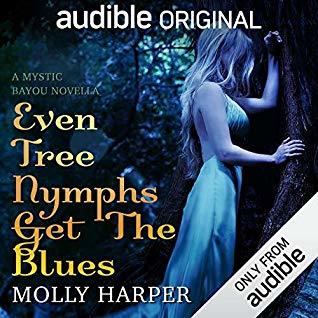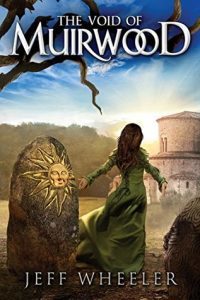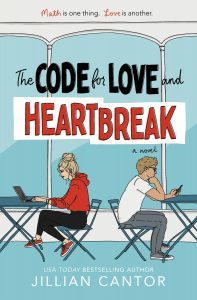C.A. Gray's Blog, page 40
May 21, 2021
Even Tree Nymphs Get The Blues, Molly Harper
Today’s podcast review comes from this blog review of Even Tree Nymphs Get The Blues.
The post Even Tree Nymphs Get The Blues, Molly Harper appeared first on C.A. Gray.
May 14, 2021
Evil Eye by Madhuri Shekar
This week’s podcast review of Evil Eye comes from this blog review.
The post Evil Eye by Madhuri Shekar appeared first on C.A. Gray.
Review of Even Tree Nymphs Get The Blues

I never would have picked this book up (the title would have scared me away!) except that it was a freebie on Audible. But it was surprisingly cute, and tongue-in-cheek. The story: in a world where supernatural creatures intermingle with humans, the ageless tree nymph Ingrid keeps to herself after having her heart broken (seventy years ago). Her only real interaction in the world of humans was her role as a model for a milk company, years earlier. But now she’s moved to Mystic Bayou, Louisiana, where she plans to use her modeling earnings to open an ice cream shop.
Rob, meanwhile, fantasized about the Eidelweiss milkmaid when he was a teenager. So when he spots Ingrid on the streets of Mystic Bayou, he’s instantly smitten — but her reticence and a misunderstanding or two get in the way of their happiness. It’s a fluffy, whimsical read, and not a big time investment.
My rating: *** 1/2
Sexual content: none that I recall
Language: none that I recall
Violence: none
Political content: none
The post Review of Even Tree Nymphs Get The Blues appeared first on C.A. Gray.
May 7, 2021
The Void of Muirwood, by Jeff Wheeler
This week’s podcast review comes from this blog review of The Void of Muirwood.
The post The Void of Muirwood, by Jeff Wheeler appeared first on C.A. Gray.
April 30, 2021
The Code for Love and Heartbreak, by Jillian Cantor
Today’s podcast review comes from this blog review of “The Code for Love and Heartbreak.”
The post The Code for Love and Heartbreak, by Jillian Cantor appeared first on C.A. Gray.
April 29, 2021
Review of Evil Eye

This was a quick, engaging listen about an Indian American woman who has a difficult relationship with her much more culturally conservative mother. At first we think her mother is just obsessed with arranging a marriage for her daughter with a nice Indian boy of whom she approves. Then as the main character meets a boy that ostensibly checks all her mother’s boxes, and her mother becomes obsessively worried that he is somehow bad for her anyway, we start to think that her mother has a mental health problem, especially as she consults her astrologer for guidance. But later it becomes clear that her mother specifically believes that the boy is a reincarnation of a boy she once dated before her daughter’s birth: a boy who was abusive and who died in a skirmish in which he was trying to kill her mother instead. Now we think her mother is REALLY nuts, and so does the main character… only, she’s not. It’s almost like an X-files episode. Could hardly stop listening!
My rating: ****
Language: none
Violence: threatened mostly; definitely suspenseful but not really gory
Sexual content: none that I recall
Political content: none that I recall
The post Review of Evil Eye appeared first on C.A. Gray.
April 23, 2021
Shades of Milk and Honey by Mary Robinette Kowal
Today’s podcast review comes from this blog post review of Shades of Milk and Honey.
The post Shades of Milk and Honey by Mary Robinette Kowal appeared first on C.A. Gray.
Review of The Void of Muirwood

What a satisfying conclusion to another great trilogy!
As rich in detail and complex in characterization and plot as all of Wheeler’s other stories, this one follows now-Queen Maia through the tumults of protecting her people from a coming invasion, even while expressing incredible mercy and pity towards her enemies because “they know not what they do.” She’s tempted and betrayed in every possible way, yet she holds fast to her Maston principles (whose tomes are essentially the Bible, as I recognize quite a few of their verses). When it seems everyone but her has or will someday achieve their heart’s desire, she does not allow herself to wallow in jealousy or self-pity, as she knows this will make the Medium flee from her. When it seems she has lost everything and has no hope left, she clings to her faith in the Medium’s will, even though she knows Its will may mean her own destruction, and may look evil in every way. (And Wheeler is an unpredictable author: his endings are not always exactly happily-ever-after. So there were moments in there where I really thought he was going to leave Maia, and us, in utter devastation.) But her faith and trust against all odds is overwhelmingly rewarded: the end brings blessings galore, even those that seemed forbidden to her throughout the entire series. In a book set in our world, I might accuse the author of a deus-ex-machina fallacy, to suddenly introduce a new rule which allows for such reversal. But there’s so much suspension of disbelief in Wheeler’s worlds anyway that it just works.
The afterword at the end gave some fascinating context: Wheeler was inspired to write the character of Maia by the real-life saga of Queen Mary, aka Bloody Mary (which seems an odd choice, since I always thought of her as a villain, and Maia is goodness personified). All of her back story is inspired by the queen’s various escapades, even down to her betrothal to a foreign royal though they were kept apart for years. This makes me want to watch a documentary on Bloody Mary now.
My rating: *****
Language: none
Sexual content: none
Violence: fantasy only
Political content: none
The post Review of The Void of Muirwood appeared first on C.A. Gray.
April 19, 2021
Review of The Code for Love and Heartbreak

I liked this way more than I expected to! I usually guess from an illustrated cover like this that I’m going to get a piece of fluffy, politically correct chick lit. While that’s exactly what it was, it had one (for me) major redeeming quality: it was a retelling of Jane Austen’s “Emma.” I knew this going in (otherwise I never would have bought it), but I think I expected it to be looser than it was. It was Emma with a very modern twist: instead of simply fixing people up, she’s a coder who literally writes a dating app for coding club in her high school. What really hooked me was the fact that all the characters had the same names as in the original, or very close to the same names in some cases. This meant that I had emotional associations for and attachments to all of the characters the second they were introduced.
This version of Emma is a nerd, not a beautiful young socialite who happens to not care to marry. Instead of marriage with children, her sister Izzy went off to college with John on the other side of the country. John’s younger brother George (Knightley) is Emma’s neighbor and family friend, but they aren’t really friends with each other so much as rivals in all of their classes. Now, they’re co-presidents of the coding club. He disapproves of her dating app idea for the state coding competition, but it catches on… and, like the original Emma’s disastrous matchmaking attempts, it has unintended consequences.
The character of Frank Churchill this time is called Sam as a nickname. Certain elements of his original dynamic with Emma and Jane don’t fit into modern times. Nobody in high school would really be engaged, secretly or otherwise, so the author had to go about it differently. Harriet Smith in this version is called Hannah (I guess Harriet is too old-fashioned) and rather than her low status deriving from her uncertain parentage, in this case she’s a freshman to Emma’s and George’s senior. One thing that kind of didn’t work for me was that in the Victorian era, there was no courtship at all: there was flirtation followed by engagement, or flirtation followed by heartbreak. This left opportunity for misunderstandings, such as when Harriet believed that Mr Knightley was in love with her and likely to marry her, when in fact he was just being kind on someone else’s behalf. Such misunderstandings could never occur today, so the author had to have characters actually date people they didn’t truly have feelings for. She explains this away as a sense of obligation in order to show faith in their app, but I can’t see any of them actually doing this–it would be too deliberately misleading and cruel, and the person getting “used” would be rightly outraged when they found out about it. Yet that never happens in the book.
While this version of Emma isn’t really all that likable, I guess the original wasn’t either… yet they are both identifiable, which is all that matters in a main character I suppose. I did love the dynamic between Emma and George as much as I did in the original. Once I got about 2/3 in, I didn’t want to put it down.
My rating: ****
Language: none that I can recall
Sexual content: alluded to but only vaguely, not present in the story
Violence: none
Political content: present, in an annoyingly overt box-checking kind of way. But, it’s a mainstream chick lit book, what did I expect.
The post Review of The Code for Love and Heartbreak appeared first on C.A. Gray.
April 16, 2021
A Study in Charlotte, Brittany Cavallaro
Today’s podcast review comes from this blog review of A Study in Charlotte.
The post A Study in Charlotte, Brittany Cavallaro appeared first on C.A. Gray.



